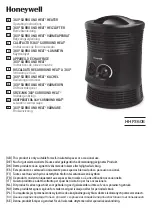
2.5.20 357-05617-03 Rev A © Inovonics, 2020 - www.inovonics.com
4
3.
Connect a momentary switch to the reset input and ground (Figure 7,
“EN4204R terminals”). Must be configured for UL installations.
• The reset input circuit permits installation of a remote momentary
normally open (N/O) switch to clear faults, unlatch outputs, and reset
the receiver to a normal state.
4.
Connect cabling to the output terminals. Must be configured for UL
installations.
• The EN4204R provides five Form-C relays.
Figure 7
EN4204R terminals
3.4 Mount the Receiver
Caution:
Mount the receiver in a location removed from metal. Metal
objects (duct work, wire mesh screens, boxes) will reduce RF range.
Note:
For UL listed systems containing a UL hold-up switch, the EN4204R
must be located within three feet of a system keypad in a location out of
sight from the protected premise.
1.
Use the provided anchors and screws to mount the receiver in a
location accessible for future maintenance, making sure the housing is
flush with the wall and the back tamper switch is actuated.
2.
After all transmitters have been registered, perform a walk test,
activating each transmitter assigned to the receiver and ensuring a
good signal.
4 Return to Factory Configuration
The EN4204R four zone add-on receiver with relay outputs can be returned
to factory defaults using the following.
Caution:
This procedure will erase all programmed point and output
information.
To restore the factory configuration defaults to the receiver:
1.
Hold down the reset and advance buttons.
2.
With the buttons held down, cycle power.
5 Specifications
UL compatible repeater, transmitters: EN5040-T, EN1215EOL,
EN1215WEOL, EN1223D, EN1235SF, EN1235DF, EN1244, EN1245,
EN1249, EN1261HT.
Housing: 6.38" x 3.60" x 1.10" (162 mm x 92 mm x 28 mm).
Operating environment: 32°- 140°F (0°- 60°C), 90% relative humidity, non-
condensing.
Power requirement: 11 - 14 VDC; 400 mA.
Current consumption: Approx. ~400 mA max with all five relays energized.
Output specifications: Form C relay 1A @ 28 VDC, 0.5A @ 30 VAC
resistive load; N/O receiver case tamper contact closure, N/C receiver jam
output indication.
Input specifications: A low is less than .5 V; a high is greater than 2.5 V.
Reset input: Contact closure, momentary low.
Receiver type: Frequency hopping spread spectrum.
Operating frequency: 915-928 MHz (Australia), 921-928 MHz (New
Zealand), 902-928 MHz (USA).
Number of points/transmitters: Four.
Number of alarm outputs: Four Form C relay outputs.
Number of fault outputs: One Form C relay output.
UL listings: UL 365, UL 636, UL 985, UL 1023, ULC/ORD-C1023-74, UL
1610, UL 1076.
Note:
Inovonics supports recycling and reuse whenever possible. Please
recycle these parts using a certified electronics recycler.
6 UL Requirements
• Due to the trouble output being shared by all transmitters, this receiver
must be set up and programmed as a commercial and residential
burglary receiver.
• The control panel must be programmed to indicate an alarm if the
system is in an armed condition and an RF jamming signal occurs at
the receiver.
• The receiver tamper and transmitter tamper cannot be combined in
one loop.
• The control unit providing input power to the receiver must not have a
range outside of 11-14 VDC.
7 Television and Radio Interference
This equipment has been tested and found to comply with the limits for a
Class B digital device, pursuant to Part 15 of the FCC Rules. These limits
are designed to provide reasonable protection against harmful interference
in a residential installation. This equipment generates, uses and can
radiate radio frequency energy and, if not installed and used in accordance
with the instructions, may cause harmful interference to radio
communications. However, there is no guarantee that interference will not
occur in a particular installation. If this equipment does cause harmful
interference to radio or television reception, which can be determined by
turning the equipment off and on, the user is encouraged to try to correct
the interference by one or more of the following measures:
• Reorient or relocate the receiving antenna.
• Increase the separation between the equipment and receiver.
• Connect the equipment into an outlet on a circuit different from that to
which the receiver is connected.
• Consult the dealer or an experienced radio/TV technician for help.
8 FCC Part 15 and Innovation, Science and
Economic Development Canada (ISED)
Compliance
This device complies with part 15 of the FCC Rules, and ISED license-
exempt RSS standard(s). Operation is subject to the following two
conditions: (1) this device may not cause interference, and (2) this device
must accept any interference that may cause undesired operation of the
device.
Le présent appareil est conforme aux CNR Innovation, Sciences et
Développement économique Canada applicables aux appareils radio
exempts de licence. L'exploitation est autorisée aux deux conditions
suivantes: (1) l'appareil ne doit pas produire de brouillage, et (2) l'utilisateur
de l'appareil doit accepter tout brouillage radioélectrique subi, même si le
brouillage est susceptible d'en compromettre le fonctionnement.
Caution:
Changes or modifications not expressly approved by the party
responsible for compliance could void the user's authority to operate the
equipment.
Vs
Ja
m
output
Ground
Ta
m
p
er
Re
set i
n
put
Caution: Incorrect
connections may cause
damage to the unit
NC
COM 1
NO
NC
COM 2
NO
NC
COM 3
NO
NC
COM 4
NO
NC
FA
U
LT
NO























